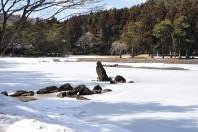
Located in the Tohoku or Northern Japan that severely suffered from earthquake and tsunami in 2011, Hiraizumi was selected as a World Heritage Site, since then the government used the inscription as the symbol of hope of this region. From Matsushima, a beautiful bay near Sendai which was hit by tsunami, I took a train to Hiraizumi. After kept my luggage in the coin-storage, I walked from the very lovely train station to Motsu-ji Temple. The town itself looked very clean and new, hard to believe its status as historic town, I thought this was the result of World Heritage Site beautification process. After short nice walked I was at Kanjizaio-in, the temple ruin was actually a large lawn with some trees and bushes around a pond, a fine place but nothing remarkable.
Motsuji Temple was my next destination, as I visited in March, this ancient garden turned to be the ice rink! However, the garden was lovely and photogenic with stones and pebbles around the pond similar to many Zen gardens in Kyoto, the most important part of the garden was the standing rock, if you saw some old photograph, you may notice that the rock had been changed its position! Then I took the bus to Chusonji Temple, the bus system of Hiraizumi was really well designed for tourists, there was a loop line called Run Run Line (pronounce like “ruin ruin” and be careful there is another bus line called Ran Ran Line that connect Hiraizumi with nearby town of Ichinoseki and pronounce like “run run”) and the bus connected all World Heritage Sites together, and with Day Pass at 400 Yen could save a lot of money and time.
As Chusonji was located on the high hill, the entrance pathway was surprisingly steep thru the pine forest. Along the way, there were many old wooden shrines and buildings which were quite lovely but nothing unique compared to other similar hilltop temples in Japan. The main attraction was the Golden Hall of Konjikido which located behind the glass wall, was quite small than I anticipated, but it was pretty amazing to see such brilliant gold building with many lovely details and looking it was quite spiritual enlightenment. After Konjikido, I saw its old storage building and a museum which kept many artifacts, one of most remarkable was the Buddhist Bible written in silver and gold. By the small down hill road next to the museum, I went to see the ruins of the paradise garden; the garden was quite similar to Kanjizaio-in, however much smaller. Muryokô-in, this site again similar to the other was an empty space with some stones and very shallow ponds.
After visited all those sites, the best site I saw was Motsuji since it reminded me the garden of Byodoin in Uji which was another World Heritage Site and was constructed in the same period and by the same Fujiwara Clan. For Konjikido Golden Hall, it cannot be considered unique as Japan has another golden building, the famous Kinkakuji, also in East Asia, there are many golden halls which are bigger than Konjikido, but as I mentioned, it was truly amazing piece of art and should be seen. In my opinion Hiraizumi was quite a mix of Kyoto temples in the location of Nikko. All in all Hiraizumi was a fine place, in the region which quite lack of significant cultural sites compared to other parts of Japan, Hiraizumi could be a nice place to visit. I recommended combining Hiraizumi trip with Matsushima and Yamadera which was considered top three cultural sites in this region.
More on
Comments
No comments yet.
